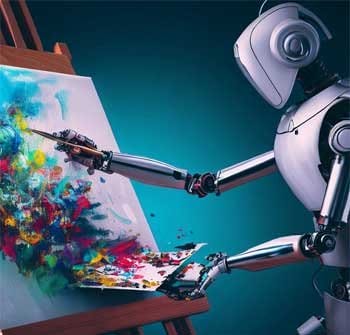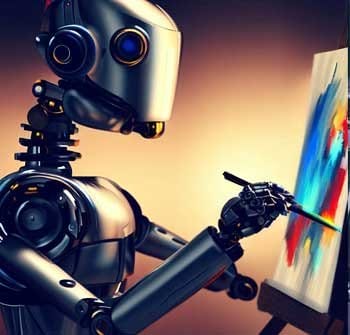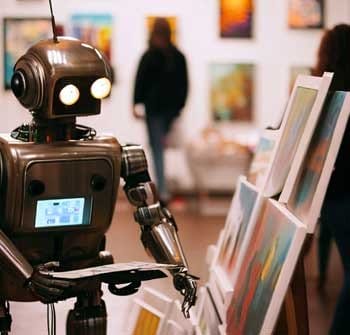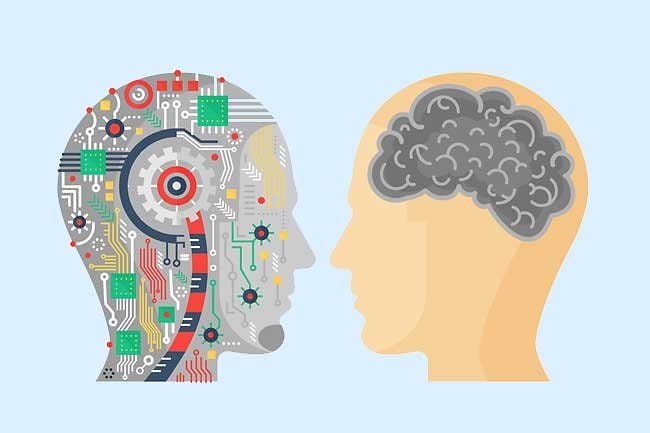The world of art is ever-evolving, and with the advent of technology, it has taken a new turn toward artificial intelligence (AI). AI Art, as it’s popularly known, is an innovative form of art that is created with the help of algorithms and machine learning.

AI Art is essentially the product of machines programmed to mimic or replicate human creativity. It’s an exciting new frontier in the art world, offering a fresh perspective on creativity and the potential to push the boundaries of what is considered ‘art’.
Whether you’re an artist looking to diversify your portfolio or an art enthusiast curious about this new genre, understanding AI Art is the first step towards exploring its potential.
This fascinating blend of creativity and technology has opened up a new avenue for artists and art enthusiasts alike. In this comprehensive guide, we will delve into the intriguing world of AI Art, exploring its legality, market demand, and how you can Sell AI Art Online to generate an additional income stream.
In the following sections, we will discuss everything you need to know about selling AI Art online, from the legality of selling AI-generated art to the best platforms for showcasing your creations. We will also look into why AI Images is here to stay, making it a promising avenue for artists looking to expand their reach and income. So, let’s embark on this journey and unravel the mysteries of AI Art together.
Are you concerned regarding the legality of AI generated art? Read our post on AI Art: Threat or Opportunity for Artists?
Understanding Ai-Generated Art
What is AI Art?
AI Art, or artificial intelligence art, is a modern form of digital artwork that leverages machine learning algorithms to create unique and captivating images. The process involves feeding an AI system a series of inputs or ‘prompts’, which it then interprets to generate artwork. This can range from abstract designs to more realistic representations, depending on the sophistication of the AI system and the prompts provided.

How is AI Art Generated?
AI Art is created using specific AI models trained with a variety of datasets. These datasets often contain a multitude of images, which the AI system learns from and uses as a reference when creating new art. The system takes a prompt from the user, such as a description or a basic sketch, and translates it into an image.
Popular Types of AI Art
Different styles of AI Art have gained popularity over time, some of which include:
| Realism: This style aims to replicate real-world images as closely as possible. |
| Abstract Art: This style focuses on creating art that doesn’t attempt to represent an accurate depiction of visual reality. |
| Pop Art: This style uses bold and bright colors, often incorporating popular culture elements. |
| Expressionism: This style seeks to express emotional experience rather than physical reality. |
| Cubism: This style involves presenting a subject from multiple angles all at once. |
| Surrealism: This style seeks to release the creative potential of the unconscious mind, for example by the irrational juxtaposition of images. |
| Impressionism: This style aims to capture the sensory effect of a scene rather than the fine details, often through use of bold colors and loose brushwork. |
| Minimalism: This style uses simple and fundamental shapes or colors to create a work, focusing on the essence of the subject. |
| Post-Impressionism: An extension of Impressionism, this style uses vivid colors and distinctive brushstrokes, and often incorporates symbolic and emotional content. |
| Futurism: This style emphasizes speed, technology, youth, and objects such as the car, the airplane, and the industrial city. |
Legal Aspects of Selling Your AI Art

Is it Legal to Sell AI Art?
Selling AI Art is generally legal, but it’s important to be aware of certain considerations. For instance, you should ensure that the AI model you’re using doesn’t rely on copyrighted images. If it does, you could potentially infringe on someone else’s intellectual property rights. It’s always best to use an AI model that has been trained on copyright-free images or to get explicit permission from the copyright owner if necessary.
Copyright Considerations
In the realm of AI Art, copyright can be a complex issue. As per US copyright law, AI-generated art lacks human authorship and thus cannot be copyrighted. This doesn’t prevent you from selling the art, but it does mean that others could potentially use the same AI model to create similar pieces. Laws can vary by country, so it’s essential to familiarize yourself with the copyright laws in your specific region.
Commercial Rights
When using AI tools to generate art, it’s important to check the terms and conditions of the tool. Some AI generator companies, like Dall-e 2 and Midjourney, grant commercial rights, allowing users to sell the images they create. Be sure to read the terms of use carefully to ensure you have the right to sell the AI-generated art commercially.
Ethical Considerations
While selling AI Art is legal, it’s also worth considering the ethical implications. Some individuals may find it unethical to profit from AI-generated images that aren’t your original work. As an artist, it’s up to you to navigate these ethical considerations and decide what feels right for you.
Is There a Demand for AI Generated Images?
Indeed, the demand for AI Art is on the rise. As technology continues to evolve, so does the intrigue and fascination surrounding AI-generated art. The novelty of AI Art, coupled with the unique blend of technology and creativity, captivates art enthusiasts across the globe. AI Art offers a fresh perspective on the concept of art, leading to an increasing number of people willing to purchase and invest in it. From private collectors to public exhibitions, AI Art is carving out its own space in the world of art.
Trends in the AI Art Market
The AI Art market has been experiencing significant growth in recent years, with a variety of styles and genres gaining popularity. Abstract designs, contemporary themes, pop art influences, and realistic representations are all part of the diverse range of AI Art available. This diversity caters to a broad spectrum of tastes and preferences, providing artists with a wide array of opportunities to explore and find their niche in this evolving market.
Tips for Selling Ai-Generated Art
| Understand Your Audience: To successfully sell your Ai-generated artwork, it’s vital to understand who your potential buyers are. Knowing what they appreciate, what kind of art they’re drawn to, and what they’re willing to invest in can help guide your creative process and marketing strategy. Create and sell what people want to buy is the secret to making money. |
| Experiment with Styles: The world of ai generated art is vast and diverse. Don’t limit yourself to one style or genre. Experimenting with different styles can help you discover what resonates with your audience and what you enjoy creating the most. |
| Stay Updated: The AI Art market is dynamic and ever-changing. Staying updated with the latest trends, advancements in AI technology, and shifts in consumer preferences can help you stay relevant and competitive in the market. |
| Promote Your Work: Utilize social media platforms and online art marketplaces to showcase your work and reach a wider audience. Effective promotion is key to increasing visibility and attracting potential buyers. |
| Quality Over Quantity: While it may be tempting to generate a large volume of AI Art, focusing on the quality of your work is more important. High-quality, unique pieces are more likely to stand out and attract buyers. Remember, AI Art is not just about leveraging technology, but also about showcasing your artistic vision and creativity. |
| Handle Criticism: As an AI artist, you may face criticism from traditional artists or art enthusiasts who view AI Art as a threat. It’s essential to be ready for this and have a well-thought-out response. Explain that AI Art is not designed to replace traditional art but to complement it. It’s a new form of art that offers unique possibilities and is a testament to the evolution of creativity and technology. |
| Continually Improve Your Skills: While AI does much of the heavy lifting in creating AI Art, your input and creativity are still vital. The ai prompts you give to the system and the edits you make to the generated images significantly impact the final piece. Therefore, it’s important to continually enhance your skills. Learn about different art styles and techniques. Understand color theory, composition, and other art fundamentals. The more you know, the better prompts you can give to the AI, and the more effectively you can edit the generated images. Keep experimenting, learning, and growing as an artist. This will not only improve the quality of your AI Art but also increase its appeal to potential buyers. |
Platforms for Selling AI-Generated Images

In the rapidly evolving world of digital art, AI-generated artwork has carved a niche for itself, captivating audiences with its unique blend of creativity and technology.
For artists creating such innovative pieces, numerous online platforms offer opportunities to showcase and sell their work. These platforms cater to different types of digital art and offer various features to support artists. Here are a few of the larger platforms:
Art Marketplaces:
Other art marketplaces where you could sell your AI-generated art include Artmajeur, UGallery, and Zatista.
Stock Image Platforms:
Additional stock image platforms include Getty Images and iStock.
Print-on-demand Platforms:
Other Print on Demand platforms worth considering are Printful, Zazzle, and CafePress.
Each platform has its own advantages and challenges. Staying active, posting regularly, and engaging with the community can increase your chances of success. Building a portfolio and finding your niche is key to standing out in the AI art market.
Challenges When You Start Selling AI Artwork
| Market Saturation: With the increasing popularity of AI art, the market can become saturated, making it harder for new artists to get noticed. |
| Copyright Concerns: Legal implications can exist if the AI model was trained on copyrighted images. Artists need to ensure they have the rights to sell the AI-generated art. |
| Quality Control: Since AI-generated art is machine-made, maintaining consistent quality can be challenging. The AI might produce pieces that don’t meet your quality standards. |
| Authenticity: Some art buyers may question the authenticity of AI-generated art, viewing it as less valuable than human-created art. |
| Pricing: Determining a fair price for AI-generated art can be difficult due to its relatively new presence in the art market. |
| Technical Knowledge: While AI does most of the work, some technical knowledge is still required to operate AI software and generate art. |
| Ethical Considerations: Some people might consider selling AI-generated art as unethical, especially if the artist relies solely on AI and contributes little to no human creativity. |
| Platform Restrictions: Some platforms may have restrictions or policies against selling AI-generated art. |
| Customer Perception: Convincing customers about the value and uniqueness of AI-generated art can be challenging. |
| Competition: As more artists start selling AI-generated art, the competition becomes stiffer, making it harder to make sales. |
The Future of Ai Generated Art
Artificial Intelligence has revolutionized various industries, and the art world isn’t an exception. AI Art is a fascinating blend of technology and creativity, producing unique pieces that have caught the attention of art enthusiasts globally.

The process of creating AI Art, which involves feeding an AI system with data and letting it generate art, has opened up a new realm of possibilities in the art world. The capability of AI to create art that mirrors human creativity is a testament to its potential and a clear indication of its enduring presence in the art landscape.
The future of the AI Art market looks bright and promising. With advancements in AI technology, the capability to create more complex and intriguing pieces of art is expanding. As an appreciation for AI Art grows, so does the potential market for it.
The unique blend of creativity and technology that AI Art offers is likely to continue captivating audiences, suggesting a continued expansion of the market. This presents a potentially lucrative opportunity for artists looking to diversify their portfolios and generate an additional income stream.
Impact on Traditional Art
The advent of AI Art has sparked a debate among artists and art enthusiasts. Some view it as a threat to traditional art, fearing that AI-generated pieces may devalue the work of human artists. However, this perspective overlooks the potential of AI as a tool rather than a replacement for human creativity.
AI Art offers a new medium for artists to express their creativity and explore uncharted artistic territories. It can serve as a source of inspiration, providing artists with unique ideas and perspectives they might not have considered. Rather than replacing traditional art, AI Art complements it, enriching the art world with its unique contributions.
AI Art in the Creative Industry
The influence of AI Art isn’t confined to the art world. Its potential has been recognized by various industries, including advertising, fashion, and entertainment. The ability of AI to generate unique, captivating images quickly and efficiently makes it a valuable tool in these sectors. Advertisers can use AI Art to create eye-catching visuals for their campaigns. Fashion designers can utilize it to generate innovative design ideas.
The entertainment industry can use AI-generated art for everything from album covers to movie posters. As AI technology continues to advance, we can expect its influence in the creative industry to grow, opening up new opportunities for artists adept in AI Art.
Final Thoughts
Art has been around for thousands of years, constantly evolving with each generation. AI Art represents the latest stage in this evolution. As technology continues to advance, we can expect AI Art to become more sophisticated, offering even greater possibilities for creativity. However, no matter how much technology advances, the essence of art—the expression of human emotion and experience—will always remain.
I believe the future of AI Art is bright. It is a dynamic and exciting field that offers new opportunities for artists and creatives. While it may face criticism and challenges, its potential to transform the art world and beyond is undeniable. As we look to the future, one thing is clear: AI Art is not just a passing trend—it’s a new frontier in the world of art.

